by Philip Graham
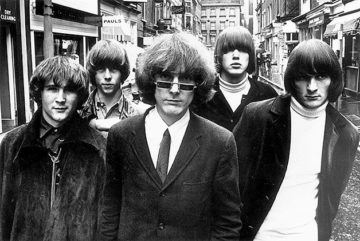 In the early months of 1966, whenever a familiar look of boredom settled in my mother’s eyes at the thought of cooking, I’d suggest, “Why don’t we go out for pizza?”
In the early months of 1966, whenever a familiar look of boredom settled in my mother’s eyes at the thought of cooking, I’d suggest, “Why don’t we go out for pizza?”
She always agreed. Our pizzeria of choice was conveniently located on a one-block strip mall less than a mile away, between a pharmacy and a dry cleaner. Sometimes we’d do a two-fer and stop at the laundry first. My beleaguered mother was always pleased to eat a meal she didn’t have to cook, and pick up clothes she didn’t have to wash and dry. I’d learned long ago how to work my way around her moods. In this case I nurtured an ulterior motive.
The pizza never rose above standard New York-style fare, but I always talked it up—“Mmmm, so good!”—all because of the jukebox in the corner. More specifically, because of one record in that jukebox: the single, “Turn! Turn! Turn!” by the Byrds. The hit song didn’t draw me there, however; the B side did: “She Don’t Care about Time,” written by Gene Clark, the band’s most prolific songwriter. Inexplicably, it hadn’t been included on either of the Byrds’ two albums, and this pizza joint offered my only opportunity to hear it.
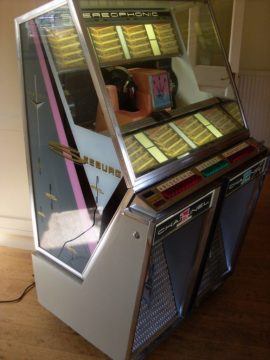 I had memorized the jukebox code of the song’s title card—G-5. I slipped in a dime, pressed the plump, candy-colored keyboard pads, and then reveled in the anticipatory pleasure of watching the mechanical arm pick “She Don’t Care about Time” from the stack of 45s and deliver it to the turntable.
I had memorized the jukebox code of the song’s title card—G-5. I slipped in a dime, pressed the plump, candy-colored keyboard pads, and then reveled in the anticipatory pleasure of watching the mechanical arm pick “She Don’t Care about Time” from the stack of 45s and deliver it to the turntable.
At once, the crystalline tones of band leader Jim McGuinn’s 12-string Rickenbacker guitar rang out (a sound that had immediately defined the “jingle jangle” of folk rock with the Byrds’ first single, “Mr. Tambourine Man”). There, too, soared creamy vocal harmonies enriched by David Crosby’s voice, but the guitar break was the moment I waited for—McGuinn had copped a melody from Bach, “Jesu, Joy of Man’s Desiring,” and casually created electrified Bach! Then, at the end of the song came the surprise of “I see her all in my mind,” revealing that the singer’s “she” is imaginary, idealized.
Perfect for a fourteen-year-old still far from his first date.
How could this gem have been left off the album? The song, a mere two-and-a-half
minutes long, always ended too soon. I dropped in another coin and played it again.
And again.
“Can’t we listen to some other song?” my younger brother inevitably complained. I ignored him as long as possible until he cajoled our mother, smoking a cigarette and miles away, into intervening. I gave in as graciously as I could manage. Another day would eventually arrive when her eyes in the kitchen glazed over, and once again I could listen to my favorite rock band’s orphaned song.
This was just the beginning of my scheming as a fan.
In the 1960s, I followed the fortunes of a batch of bands and musicians—the Beatles and the Stones, the Four Tops, Bob Dylan, Taj Mahal, Jimi Hendrix, the Blues Project, Donovan, the Doors, John Mayall, Joni Mitchell and Tim Buckley, Miles Davis and Charles Mingus, Buffalo Springfield, Procol Harum, the Supremes, Country Joe and the Fish, and more. Jumping from record to record, I balanced my enthusiasms without the Byrds ever losing their favored place in my esteem.
Sure, the Beatles had declared that the Byrds were their favorite American band (the
Byrds’ folk rock innovations had influenced Rubber Soul), yet that didn’t explain why the Byrds ruled above all others for me.
The beauty, power, and inventiveness of their music are the obvious reasons. But it took me years to suss out that the hidden key to my devoted fandom must have begun with Derek Taylor’s liner notes for the Turn! Turn! Turn! album, where he parted the curtain of the Byrds’ creative process. Apparently there were “constant artistic conflicts within the group” and “little chance that a song will be recorded without a dozen fistfights and mouthfuls of awful abuse.” Yet Taylor gleefully approved of this, noting that all their “bark and bite” was in the service of “striving for a thoroughly argued compromise.”
Arguing could make things better? Arguing could help improve your art?
Three years earlier, endless arguments between my gentle father and my not-so-gentle and sometimes violent mother had escalated, forcing me more than once to hurl myself between them to prevent disaster. Though my parents eventually backed away from catastrophe, a lingering resentment and hurt still fueled their daily life. Would they ever completely heal?
And then came along a rock ‘n roll band that—admittedly!–transformed intense
contention into compromise and then beauty. How could I not love the Byrds?
*
When songwriter and singer Gene Clark left the group, due to internal politics and a
growing fear of flying, he did so at one of the Byrds’ creative pinnacles: “Eight Miles High.” A brilliant rock and roll amalgam of the spiritual jazz of John Coltrane and the ragas of Ravi Shankar, this song marked the birth of psychedelia.
https://www.youtube.com/watch?v=J74ttSR8lEg
When the Byrds’ subsequent album, Fifth Dimension, steeped in psychedelic exploration, was released in the summer of 1966, it seemed like a brave reinvention yet also felt like a holding pattern. Much as I tried, the loss of Gene Clark couldn’t easily be ignored. As good as this album was, I willed myself to like what I considered lesser songs—the corny “Mr. Spaceman,” the pointless instrumental “Captain Soul,” and the dull “Lear Jet Song.” I discovered that if I listened long and closely enough, I’d find something, anything to appreciate. I also discovered that sometimes no amount of listening will completely redeem a song.
Then, in the first week of January 1967, a new single appeared, one that not only presaged the arrival of a forthcoming album, but a return to form as well.
“So You Want to Be a Rock and Roll Star,” a satiric ode to stardom written by McGuinn and bassist Chris Hillman, seamlessly blended the Byrds’ signature guitars and vocals with the guest trumpet of South African jazz musician Hugh Masekela, while the recorded screams of enthusiastic Byrds fans added an ironic counterpoint to lyrics that advised aspiring musicians to “sell your soul to the company” to “sell plasticware.”
The B side offered a different sort of perfection, a gentle, Crosby-penned torch song, featuring one of McGuinn’s most achingly lovely guitar solos and Hillman’s restless bass lines that almost served as a second lead guitar.
The Byrds had regained their footing. But this taste wasn’t enough. I had to know if the rest of the album would be equally wonderful. Who knew when it would be released? The wait made me so itchy I came up with an audacious plan.
My father, who commuted to work in New York City every day, kept a Manhattan
Yellow Pages at home. All I had to do was look up the phone number of Columbia
Records and ask.
But who would give a kid like me the time of day? I needed an adult voice. I practiced a short speech over and over in the privacy of my bedroom, trying to imagine not a version of my future self but the sound of an adult who owned a record store. I deepened my voice, tried on a tone of entitled exasperation to complete my grown-up disguise, and thus I created my first fictional character.
It took a couple of days to build up the courage, but call I did. When a secretary’s voice answered “Columbia Records, how may I help you?” my speech was ready.
“Hi, I’m the owner of Cove Record Store, here in Glen Cove, New York. Just down the
road.” Just down the road? What a stupid thing to say! But I managed to recover,
continuing, “Ever since the Byrds’ new single came out, I’m getting a lot, and I mean a lot, of young kids coming in and asking me when their album is going to be released. So, can you connect me with someone there who can give me that information?”
I braced myself for her to laugh and hang up. Instead, she transferred me to another office.
I’d never before dared such devious bravado. At the next greeting I slowed down my adult voice, to tamp down my excitement at having gotten even this far. After repeating my request, voilà!–off to another office. Up I rose in the mysterious ladder of importance in Columbia Records, until finally a slightly confused secretary said, “Oh, you want the A&R Department. Let me connect you.”
What was A&R? Aside from the Byrds’ new single, I knew nothing about the record business (I had no idea, for example, that the Byrds were contractually obligated to churn out two albums a year for Columbia Records), so what was I supposed to say when—
“A&R. What can I do for you?”
I repeated my by-now well-practiced schtick and waited. I’d gotten so far, but what if he asked me—
“Let me check,” he replied.
I almost yelped at my good fortune. I’d finally reached someone who could help.
“Okay, got it. We ship on February 6th.”
“Great!” I burst out like the kid I was, quickly switching to a deeper voiced, “Thanks, that’s gonna make a lot of kids happy. I’ll probably have to increase my order.”
*
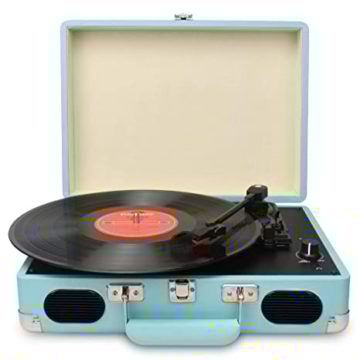 That album, Younger than Yesterday, was everything I’d hoped for. Chris Hillman now joined McGuinn and David Crosby as another accomplished songwriter, making the Byrds a triple threat, and this confident band refined and expanded their inspiration into any direction. I listened obsessively in my bedroom on a portable plastic record player. A little tinny and short on bass, it managed just fine to crowd out the arguing downstairs.
That album, Younger than Yesterday, was everything I’d hoped for. Chris Hillman now joined McGuinn and David Crosby as another accomplished songwriter, making the Byrds a triple threat, and this confident band refined and expanded their inspiration into any direction. I listened obsessively in my bedroom on a portable plastic record player. A little tinny and short on bass, it managed just fine to crowd out the arguing downstairs.
Despite the triumph of Younger than Yesterday, the Byrds’ singles no longer made it to the Top Ten and instead hovered in the nearby gray territory of Almost Hits. By the end of 1967, an increasingly-contentious David Crosby had been canned (so much for “thoroughly argued compromise”), and drummer Michael Clarke, sick and tired of it all, went on extended hookey. The original Byrds had reduced to a duo.
To complete an already in-progress fifth album, The Notorious Byrd Brothers, McGuinn and Hillman bulked up with a bevy of studio musicians and created a masterly blend of art rock, psychedelia, folk and country that many consider their best album. Meanwhile, my parents’ disputes had transformed into a kind of noisy quiet, filled with words they no longer bothered to say to each other.
The Byrds’ music, at least, remained as vibrant as ever. I should have been content, but I wanted my favorite band to transcend their self-inflicted wounds and return to past popular triumphs. Throughout my three years of fandom the steady departure of original band members was matched by a decreasing audience. And a duo is not a band. What could possibly come next?
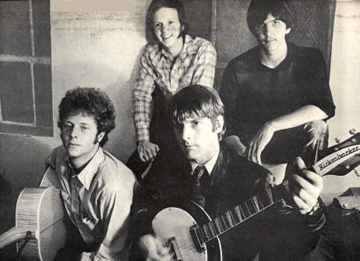 Nothing I would have expected. A new band member, Gram Parsons, nudged the Byrds into going full country, marking another bracing leap into a new musical genre.
Nothing I would have expected. A new band member, Gram Parsons, nudged the Byrds into going full country, marking another bracing leap into a new musical genre.
I’d never paid much attention to country music, but if the Byrds took it on, I prepared myself to follow. This was a big ask. At the height of the Vietnam War in the 1960s, country music was regarded by anti-war rock and rollers as a musical backwater for conservative, love-it-or-leave-it knuckle-draggers.
The first salvo of the Byrds’ new genre-busting venture was the release of a Bob Dylan song, “You Ain’t Goin’ Nowhere.” Perhaps this never-before-heard song—early public proof of Dylan’s rumored “basement tapes”—would give the band a lift. Sure, it was country, yet still recognizably the Byrds—at least, enough to lead me to an even more desperate display of fandom.
New York’s premier rock and roll radio station, WNEW, played the song, but not enough, in my opinion. One of their best DJs, Scott Muni, was a Byrds supporter. I didn’t dare attempt a repeat of my unlikely success calling Columbia records. Even if I contacted him directly at the station, what would my single fan’s voice accomplish?
A petition. Why not pass around a petition at school and mail it in?
The petitioner’s plea I typed up is lost to memory, but I imagine it must have proceeded something like this:
Dear Scott Muni,
We, the undersigned, ask that WNEW play the new Byrds’ single, “You Ain’t Goin’ Nowhere,” MUCH MORE. It’s a great Dylan song, as good as “Mr. Tambourine Man,” etc., etc., etc.
At school, only a few friends were willing to sign a petition for a song they hadn’t heard. The looks of indulgent amusement I received from other schoolmates convinced me to give it up. I returned home disappointed and in possession of a twenty-line petition with only three signatures besides my own. Where would the remaining sixteen come from? I couldn’t possibly ask my parents or brother—I was already the weirdo in the family. Anyway, our same last names would be a dead give-away that this petition was a put-up job.
Then came a thrilling, a tempting, a forbidden thought: What if I forged the rest of the signatures?
I might be able to pull it off. The signatures must not look the same, of course, so I started by writing a list of letters: all the ways an R could be written differently, or a B, a G (tricky one, that), or a T. But what about the names? If I used real names, couldn’t I be sued?
Once again, I turned to the phone book. I picked out sixteen first names, then picked sixteen last names and combined them. Slowly, I invented the fans the Byrds didn’t have enough of.
Now, to turn them into believable signatures. Using the same pen over and over again might look suspicious, so I scoured the house in search of others. Probably no one would carefully examine the signatures. But why take any chances, since I was committing a kind of fraud.
With the four extra pens I’d located, I spaced out their use in the petition. Finally, I fit in a single penciled name, which added a certain amount of authenticity to the entire document, because what were the odds that everyone who signed the petition had pens? Certainly there was one fan in the bunch who only had a pencil.
With hope and trepidation, I mailed it in. No mention, in the following weeks, of a petition from concerned Byrds admirers, no perceptible change in the number of times “You Ain’t Goin’ Nowhere” was played, and then the song left the singles rotation.
The Byrds’ resulting album, Sweetheart of the Rodeo, crashed and burned commercially, and Gram Parsons moved on to his own storied career. The Byrds may have bravely crossed a musical divide, but at least initially neither side was much impressed. Yet over the years, for generations of musicians, Sweetheart has become the beloved album that launched country rock and the broad genre of Americana.
*
In late February of 1970 I sat beside my wild-haired friend Scott in a concert hall, having driven to Queens College in New York to see the Byrds perform live. A freshman in college and beginning my own independent life, I happily lived far from my parents’ continuing cold war. I’d given up hope of their ever finding common ground.
As for my still-favorite band, the Byrds were down to a single original member, McGuinn (who somewhere along the way had decided to change his first name from Jim to Roger, as if changing band members wasn’t enough). McGuinn had spent the past year-and-a-half rebuilding the band from scratch, in an attempt to return to past glories. Now he was joined by Clarence White, a former bluegrass picker who brought breaking-the-speed-limit dexterity to his electric guitar, along with a secret weapon: a mechanical doodad that allowed him to bend the B string of his Telecaster into a steel guitar’s slippery twang when needed. Bassist Skip Battin and drummer Gene Parsons (no relation to Gram) added a jazzy bedrock to McGuinn’s 12-string Rickenbacker’s folk rock and psychedelic anthems.
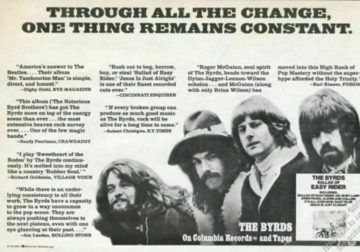 By this time, to reassure fans, Columbia Records had begun addressing the Byrds’ tumultuous history in their ads for the band: “Through All the Change, One Thing Remains Constant,” that constant being a persistent, excellent inventiveness. That ad resonated deeply within me, an aspiring writer. The Byrds’ musical shifts had grown my curiosity about other musics I might otherwise have missed. They taught me about artistic integrity, though it would take me a while to realize that internal arguing was the best kind of arguing, that the various parts of one’s inner self disputing and questioning was an ideal route for any creative artist. In later life, the example of the Byrds’ stubborn, inspired bravery shored me up whenever my own writing faltered—a lesson that further bound me to the band.
By this time, to reassure fans, Columbia Records had begun addressing the Byrds’ tumultuous history in their ads for the band: “Through All the Change, One Thing Remains Constant,” that constant being a persistent, excellent inventiveness. That ad resonated deeply within me, an aspiring writer. The Byrds’ musical shifts had grown my curiosity about other musics I might otherwise have missed. They taught me about artistic integrity, though it would take me a while to realize that internal arguing was the best kind of arguing, that the various parts of one’s inner self disputing and questioning was an ideal route for any creative artist. In later life, the example of the Byrds’ stubborn, inspired bravery shored me up whenever my own writing faltered—a lesson that further bound me to the band.
The concert hall was packed. Though this was at least the third time I would be taking in the Byrds live, I always felt a little odd to be among fellow fans. Throughout my high school years, my relationship with the Byrds had been mainly a lonely one—listening to their music on a small plastic record player in my bedroom. But in a concert hall, I was joined by a crowd of fellow believers. What had brought them here, and how many had, like me, traveled with McGuinn through all the band’s permutations for the love of the music, for the adventure of the Byrds’ evolving sonic explorations? How many had nurtured their fandom because of some private drama?
While Scott and I waited for the show to begin, word started circulating that this concert was going to be recorded. I could actually be on a Byrds’ album, even if only through my applause! Scott had a similar idea—he’d get his whistle on the record. Scott was proud that, with two fingers in his mouth, he’d easily unleash a shrill blast that could hurt your ears. I liked Scott in spite of this talent.
The Byrds roared onstage, performing a new song, “Lover of the Bayou,” with an unexpectedly gritty swamp-rock vibe. They kept trying out one new and strong song after another, and once again I could believe that the Byrds had regained their footing. Then near the end of the evening’s concert these new Byrds began what would be an ambitious, nearly sixteen-minute expansion of the original three-and-a-half minute “Eight Miles High.”
If only Scott would stop his infernal whistling.
“Hey Scott, enough—knock it off,” I hissed, “they’re recording this, don’t ruin it.” But he was too busy setting up his next blast. We stood side-by-side, and how easy for my elbow to slam into his rib cage. If you listen to this live version of “Eight Miles High,” you can hear Scott’s enthusiastic efforts up until the 30-second mark, when there’s a sudden, notable lack of whistle, due to me. I’ve always been proud of being on a Byrds record, even if my impact was a form of absence.
This version is notable for much more than my elbow’s silent starring role. The band, having started “Eight Miles High” at about 60 MPH, never takes a foot off the pedal, but it’s not another example of late 1960s jams that seem to go on forever. I have listened to the recording of this live performance countless times, amazed that this long jam never feels excessive, and I think I may have finally figured out why.
Though the playing is improvised, the structure is an ironclad, ferocious clockwork. There’s constant soloing, but no solo goes on for more than two or three minutes, each roughly corresponding to the average length of a standard ’60s rock song.
The performance can be divided into seven individual and seamless increments. McGuinn’s psychedelic lead-off solo goes on for about two minutes (A), followed by White’s hard-country rock solo, also two minutes (B). Then, the guitarists trade licks, roiling back and forth for another two minutes (C), slowly quieting as the rhythm section takes over—a bass and drums duet (D) that maintains the performance’s propulsion and forms the jam’s three-minute midpoint. Slowly, McGuinn and White return, again trading riffs ( C ) before White rips into his second solo (B), leading to the high psychedelic rush of McGuinn’s final solo (A) which, after briefly giving way to the band’s singing in full harmony the song’s first verse, continues to the jam’s conclusion.
Eventually, you end up with an arch structure that looks something like a poem’s rhyme scheme:
A: (McGuinn)
B: (White)
C: (McGuinn and White)
D: (Battin and Parsons)
C: (McGuinn and White)
B: (White)
A: (McGuinn)
The structure of this “jam” has the earmarks of Roger McGuinn’s genius as a band leader and arranger (long before forming the Byrds, he’d arranged the songs for two early Judy Collins albums). In the excitement of the moment, none of us in the audience that night could have possibly recognized this pattern, but I think we all must have intuitively felt it unfolding.
“Eight Miles High” over, the Byrds segued into “Hold It,” the short instrumental that always signaled the end of their concerts, and we leapt to our feet as one. Though (Untitled), the album on which this performance would eventually appear, would prove to be the Byrds’ last great album before a slow, sad decline, I was unaware of that future as I stood clapping along with everyone else in the elated audience, and I’m sure that somewhere in the mix of voices shouting approval can be heard my voice, too, crying out, “More!”
